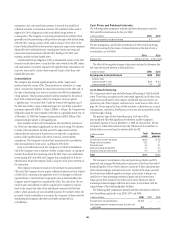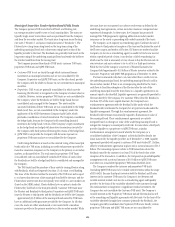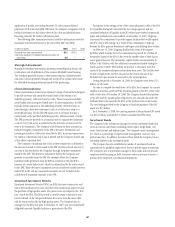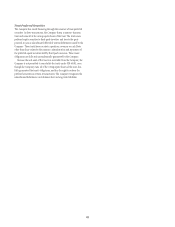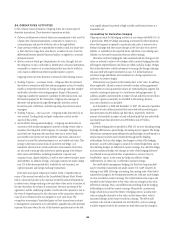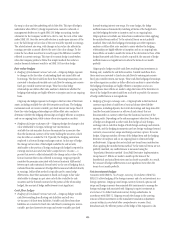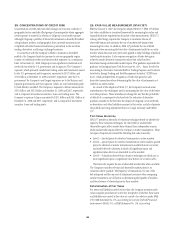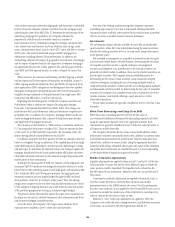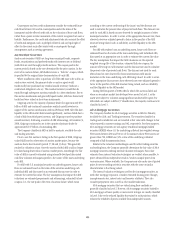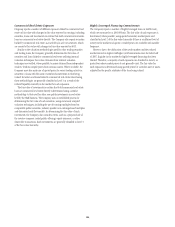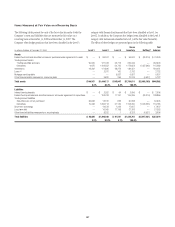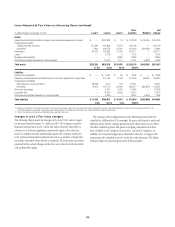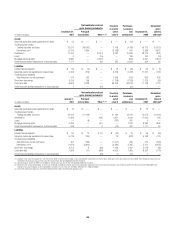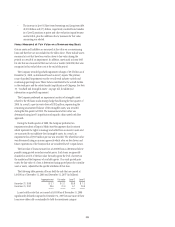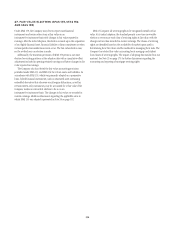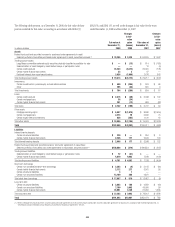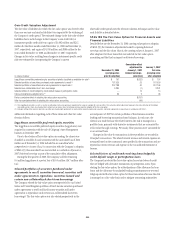Citibank 2008 Annual Report Download - page 200
Download and view the complete annual report
Please find page 200 of the 2008 Citibank annual report below. You can navigate through the pages in the report by either clicking on the pages listed below, or by using the keyword search tool below to find specific information within the annual report.value of these exposures (other than high grade and mezzanine as described
below) is based on estimates of future cash flows from the mortgage loans
underlying the assets of the ABS CDOs. To determine the performance of the
underlying mortgage loan portfolios, the Company estimates the
prepayments, defaults and loss severities based on a number of
macroeconomic factors, including housing price changes, unemployment
rates, interest rates and borrower and loan attributes, such as age, credit
scores, documentation status, loan-to-value (LTV) ratios and debt-to-income
(DTI) ratios. The model is calibrated using available mortgage loan
information including historical loan performance. In addition, the
methodology estimates the impact of geographic concentration of mortgages
and the impact of reported fraud in the origination of subprime mortgages.
An appropriate discount rate is then applied to the cash flows generated for
each ABCP and CDO-squared tranche, in order to estimate its current fair
value.
When necessary, the valuation methodology used by Citigroup is refined
and the inputs used for the purposes of estimation are modified, in part, to
reflect ongoing market developments. More specifically, the inputs of home
price appreciation (HPA) assumptions and delinquency data were updated
during the fourth quarter along with discount rates that are based upon a
weighted average combination of implied spreads from single name ABS
bond prices and ABX indices, as well as CLO spreads.
Beginning with the third quarter of 2008, the Company used the Loan
Performance Index to estimate the impact of housing price changes.
Previously, it incorporated the S&P/Case-Shiller Index. This change was
made because the Loan Performance Index provided more comprehensive
geographic data. In addition, the Company’s mortgage default model uses
recent mortgage performance data, a period of sharp home price declines
and high levels of mortgage foreclosures.
The valuation as of December 31, 2008 assumes a cumulative decline in
U.S. housing prices from peak to trough of 33%. This rate assumes declines
of 16% and 13% in 2008 and 2009, respectively, the remainder of the 33%
decline having already occurred before the end of 2007.
In addition, during the last three quarters of 2008, the discount rates were
based on a weighted average combination of the implied spreads from single
name ABS bond prices, ABX indices and CLO spreads, depending on vintage
and asset types. To determine the discount margin, the Company applies the
mortgage default model to the bonds underlying the ABX indices and other
referenced cash bonds and solves for the discount margin that produces the
market prices of those instruments.
Starting in the third quarter of 2008, the valuation of the high grade and
mezzanine ABS CDO positions was changed from model valuation to trader
prices based on the underlying assets of each high grade and mezzanine ABS
CDO. Unlike the ABCP and CDO-squared positions, the high grade and
mezzanine positions are now largely hedged through the ABX and bond
short positions, which are, by necessity, trader priced. Thus, this change
brings closer symmetry in the way these long and short positions are valued
by the Company. Citigroup intends to use trader marks to value this portion
of the portfolio going forward so long as it remains largely hedged.
The primary drivers that currently impact the super senior valuations are
the discount rates used to calculate the present value of projected cash flows
and projected mortgage loan performance.
Given the above, the Company’s CDO super senior subprime direct
exposures were classified in Level 3 of the fair-value hierarchy.
For most of the lending and structuring direct subprime exposures
(excluding super seniors), fair value is determined utilizing observable
transactions where available, other market data for similar assets in markets
that are not active and other internal valuation techniques.
Investments
The investments category includes available-for-sale debt and marketable
equity securities, whose fair value is determined using the same procedures
described for trading securities above or, in some cases, using vendor prices
as the primary source.
Also included in investments are nonpublic investments in private equity
and real estate entities held by the S&B business. Determining the fair value
of nonpublic securities involves a significant degree of management
resources and judgment as no quoted prices exist and such securities are
generally very thinly traded. In addition, there may be transfer restrictions on
private equity securities. The Company uses an established process for
determining the fair value of such securities, using commonly accepted
valuation techniques, including the use of earnings multiples based on
comparable public securities, industry-specific non-earnings-based multiples
and discounted cash flow models. In determining the fair value of nonpublic
securities, the Company also considers events such as a proposed sale of the
investee company, initial public offerings, equity issuances, or other
observable transactions.
Private equity securities are generally classified in Level 3 of the fair-value
hierarchy.
Short-Term Borrowings and Long-Term Debt
Where fair-value accounting has been elected, the fair value of
non-structured liabilities is determined by discounting expected cash flows
using the appropriate discount rate for the applicable maturity. Such
instruments are generally classified in Level 2 of the fair-value hierarchy as
all inputs are readily observable.
The Company determines the fair value of structured liabilities (where
performance is linked to structured interest rates, inflation or currency risks)
and hybrid financial instruments (performance linked to risks other than
interest rates, inflation or currency risks) using the appropriate derivative
valuation methodology (described above) given the nature of the embedded
risk profile. Such instruments are classified in Level 2 or Level 3 depending
on the observability of significant inputs to the model.
Market Valuation Adjustments
Liquidity adjustments are applied to items in Level 2 and Level 3 of the fair-
value hierarchy to ensure that the fair value reflects the price at which the
entire position could be liquidated. The liquidity reserve is based on the
bid-offer spread for an instrument, adjusted to take into account the size of
the position.
Counterparty credit-risk adjustments are applied to derivatives, such as
over-the-counter derivatives, where the base valuation uses market
parameters based on the LIBOR interest rate curves. Not all counterparties
have the same credit risk as that implied by the relevant LIBOR curve, so it is
necessary to consider the market view of the credit risk of a counterparty in
order to estimate the fair value of such an item.
Bilateral or “own” credit-risk adjustments are applied to reflect the
Company’s own credit risk when valuing derivatives and liabilities measured
at fair value, in accordance with the requirements of SFAS 157.
194



